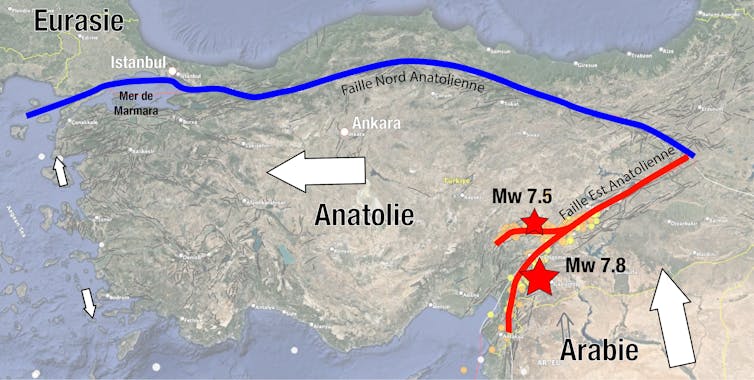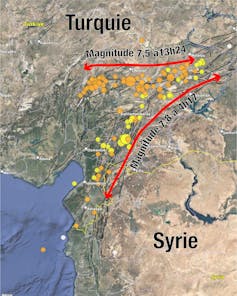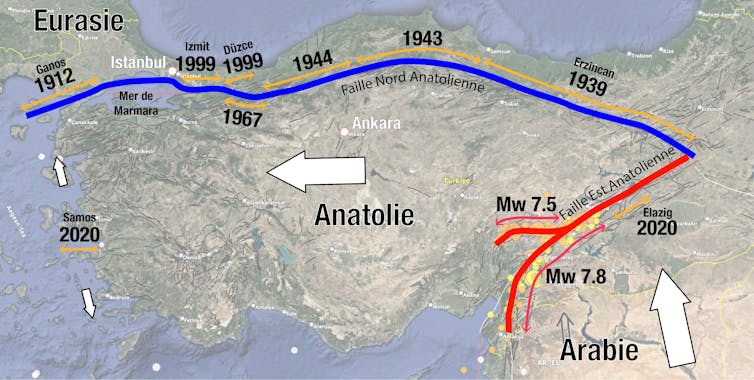Earthquakes in Syria and Turkey are common, but the magnitude 7.8 that shook the region on 6 February at 4:17am local time is clearly impressive. To find earthquakes this strong on this particular fault, we would have to go back to the year 1114.
Ten minutes after the strongest earthquake, an aftershock of magnitude 6.7 struck near the epicentre. “Aftershocks” are earthquakes that occur after every major earthquake, and their statistical behaviour is well known. At the time of writing, others continue to affect an area stretching over 350 kilometres from eastern Turkey to the Syrian border.
More surprisingly and dramatically, a second earthquake of magnitude 7.5 struck at 1:24pm local time, further north. This earthquake was not an aftershock: according to the first data processed live by the major international seismological agencies, it would have occurred on an east-west fault crossing-cutting the main rupture trace.
The Anatolian microplate is pushed westward by the northward rise of the Arabian plate, and dragged westward. This westward motion is accommodated by two major tectonic faults: the North Anatolian Fault (2 cm per year of relative motion between the Anatolian and Eurasian plates) and the East Anatolian Fault (between 5 mm and 1 cm per year of relative motion between the Arabian and Anatolian plates). We know how and why Anatolia moves, but this knowledge unfortunately cannot help us today to predict earthquakes. Romain Jolivet/ENS/Google Earth, Fourni par l'auteur
We don’t yet have all the information from satellite imagery and GPS measurements, but it appears that the second earthquake may have been caused by the first one, a hypothesis that will have to be verified in the coming days as data trickles in.
These two major seismic events on two nearby faults reflects the fact that earthquakes may cascade. Indeed, the other major fault in the region (the “North Anatolian” fault) ruptured in a series of magnitude 7 earthquakes that spread throughout the 20th century from its easternmost end, in eastern Turkey, to the megalopolis of Istanbul, much like a falling row of dominoes.
Both the scientific community and Turkish authorities expect an earthquake to strike at some point near this city of 8 million inhabitants. We do not know when such earthquake will hit or how big it will be. Based on the current state of knowledge, no one can predict its occurrence or magnitude, and this Monday’s earthquake is an unfortunate reminder that Turkey can also be hit hard elsewhere.
Aftershocks and a second earthquake
The aftershocks following Monday’s earthquake are in themselves of no surprise at all. In 1894, the pioneer Japanese seismologist, Fusakichi Omori, already observed a slow, logarithmic decrease in the number of aftershocks per day with time.
These same empirical law predicts that the magnitude of the largest aftershock will be inferior to that of the main shock by one point: in this case, the largest aftershock of the biggest earthquake had a magnitude of 6.7, close to the expected 6.8. Remember that this scale is not linear, and that an earthquake of magnitude 6 releases 30 times less energy than an earthquake of magnitude 7.
Aftershocks stop when the forces generated by the main earthquake have been accommodated. Think of what happens when you kick into a pile of sand: grains fall and roll one after the other, before eventually stabilising.
Aftershocks of the two earthquakes that took place at the border between Turkey and Syria on 6 February. Romain Jolivet/ENS/Google Earth, Fourni par l'auteur
But the magnitude 7.5 earthquake at 1:24pm is off, compared to the pattern that has been statistically verified since 1894 for thousands of earthquakes around the world: this is not an aftershock but a second earthquake. First, because its magnitude is way too large. Second, because it occurred on a fault that appears to be oriented at 45° to the East-Anatolian Fault, as evidenced by the shape of the ripple of aftershocks that followed it.
We will therefore rather speak here of a “triggered earthquake”, or at least, we will try to explore mechanisms to explain the temporal coincidence between these two major earthquakes.
Earthquakes may trigger other earthquakes
An earthquake happens when a fault – a fracture in the first kilometres of the Earth’s crust – slips rapidly, within seconds, abruptly releasing the energy that has been growing over tens to hundreds of years by the slow motion of tectonic plates. When this happens, the released energy leads to shaking of the ground: the earthquake.
Some earthquakes are linked to each other: when the fault breaks, earthquakes release part of the energy and reorganise part of it in the Earths’ crust, which can trigger new earthquakes. For instance, one can consider the series of earthquakes of magnitude greater than 7 that have cascaded from east to west for about 800 kilometres over the course of the 20th century along the North Anatolian fault. Each earthquake brought the nearby fault segment of the North Anatolian fault closer to a rupture.
The notable point is that the entire length of the North Anatolian Fault ruptured between 1939 and 1999. The last unbroken segment runs across the Sea of Marmara, very close to Istanbul, between the epicenters of the 1999 Izmit and 1912 Ganos earthquakes.
A historical sequence of earthquakes occurred in the 20th century: initiated in the east with the Erzincan earthquake in 1939 (7.8), it continued with earthquakes in 1943, 1944, 1967 and finally in 1999 with the two earthquakes of Izmit (7.6) and Duzce (7.3), separated by only a few months. Romain Jolivet/ENS/Google Earth, Fourni par l'auteur
If a fault section is already well loaded (close to rupture), when a big earthquake hits nearby, then a second earthquake might happen. Otherwise, it will be necessary to wait for the motion of tectonic plates to bring the remaining energy necessary to trigger an earthquake. This is called “static triggering”.
When giant earthquakes trigger other earthquakes… at a distance
There is also a type of triggering known as “dynamic”. In some cases, the energy excess resulting from a large earthquake is not large enough to explain the occurrence of certain earthquakes, especially if they are located far away from the epicentre of the main shock.
For example, following the 1992 Landers and 1999 Hector Mine earthquakes in California, earthquake swarms were observed several hundreds of kilometres from the epicentre. It has been shown that these earthquakes occurred exactly during the passage of the strongest seismic waves emitted by these two earthquakes. At such distances, this shaking, the seismic waves, cannot be felt by humans, but apparently, seismic faults do.
Similar observations have been made in the laboratory to show that during the passage of these seismic waves, the material that makes up the core of the fault weakens, causing a sudden sliding, i.e., an earthquake.
This kind of behaviour comes from the physics of granular media, which behave like fluids while being shaken. Shaking a pile of sand quickly will cause it to flatten under its own weight, whereas without the shaking, it would stand still.
So shaking a fault quickly can cause it to slip, producing earthquakes. It has also been observed that these seismic waves can trigger slow slippage at colossal distances. The seismic waves emitted by the Maule earthquake, a magnitude 8.9 earthquake that struck Chile in 2010, caused a slow earthquake along the Mexico subduction, about 7,000 kilometres from the epicentre.



 LA fires: Long-term exposure to wildfire smoke is poorly understood − and a growing risk
LA fires: Long-term exposure to wildfire smoke is poorly understood − and a growing risk  Thousands of satellites are due to burn up in the atmosphere every year – damaging the ozone layer and changing the climate
Thousands of satellites are due to burn up in the atmosphere every year – damaging the ozone layer and changing the climate  Swimming in the sweet spot: how marine animals save energy on long journeys
Swimming in the sweet spot: how marine animals save energy on long journeys  An unexpected anomaly was found in the Pacific Ocean – and it could be a global time marker
An unexpected anomaly was found in the Pacific Ocean – and it could be a global time marker  Drug pollution in water is making salmon take more risks – new research
Drug pollution in water is making salmon take more risks – new research  What’s so special about Ukraine’s minerals? A geologist explains
What’s so special about Ukraine’s minerals? A geologist explains  Ukraine minerals deal: the idea that natural resource extraction can build peace has been around for decades
Ukraine minerals deal: the idea that natural resource extraction can build peace has been around for decades  The UK is surprisingly short of water – but more reservoirs aren’t the answer
The UK is surprisingly short of water – but more reservoirs aren’t the answer  GesiaPlatform Launches Carbon-Neutral Lifestyle App ‘Net Zero Heroes’
GesiaPlatform Launches Carbon-Neutral Lifestyle App ‘Net Zero Heroes’  As the Black Summer megafires neared, people rallied to save wildlife and domestic animals. But it came at a real cost
As the Black Summer megafires neared, people rallied to save wildlife and domestic animals. But it came at a real cost  Parasites are ecological dark matter – and they need protecting
Parasites are ecological dark matter – and they need protecting  Extreme heat, flooding, wildfires – Colorado’s formerly incarcerated people on the hazards they faced behind bars
Extreme heat, flooding, wildfires – Colorado’s formerly incarcerated people on the hazards they faced behind bars 































